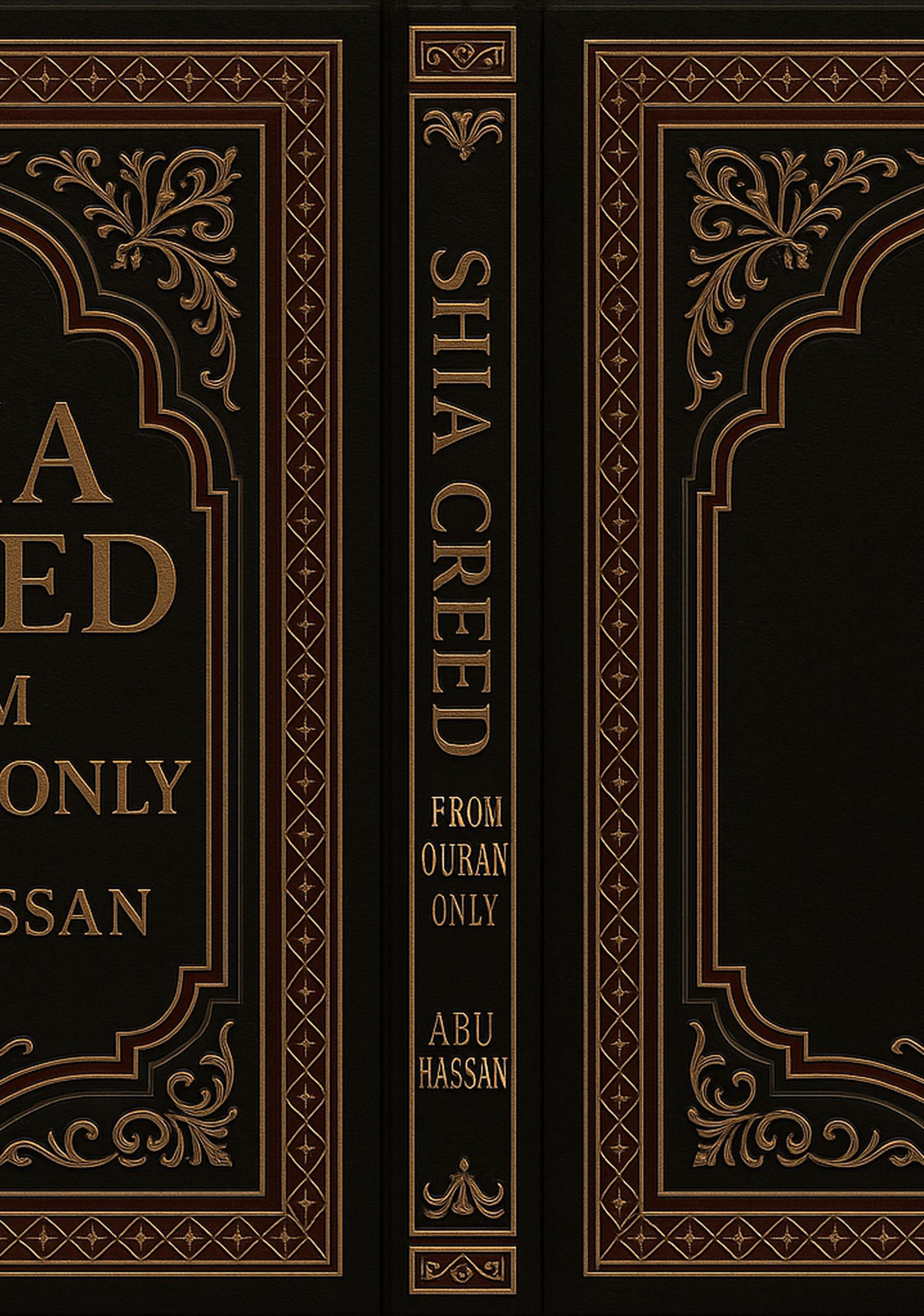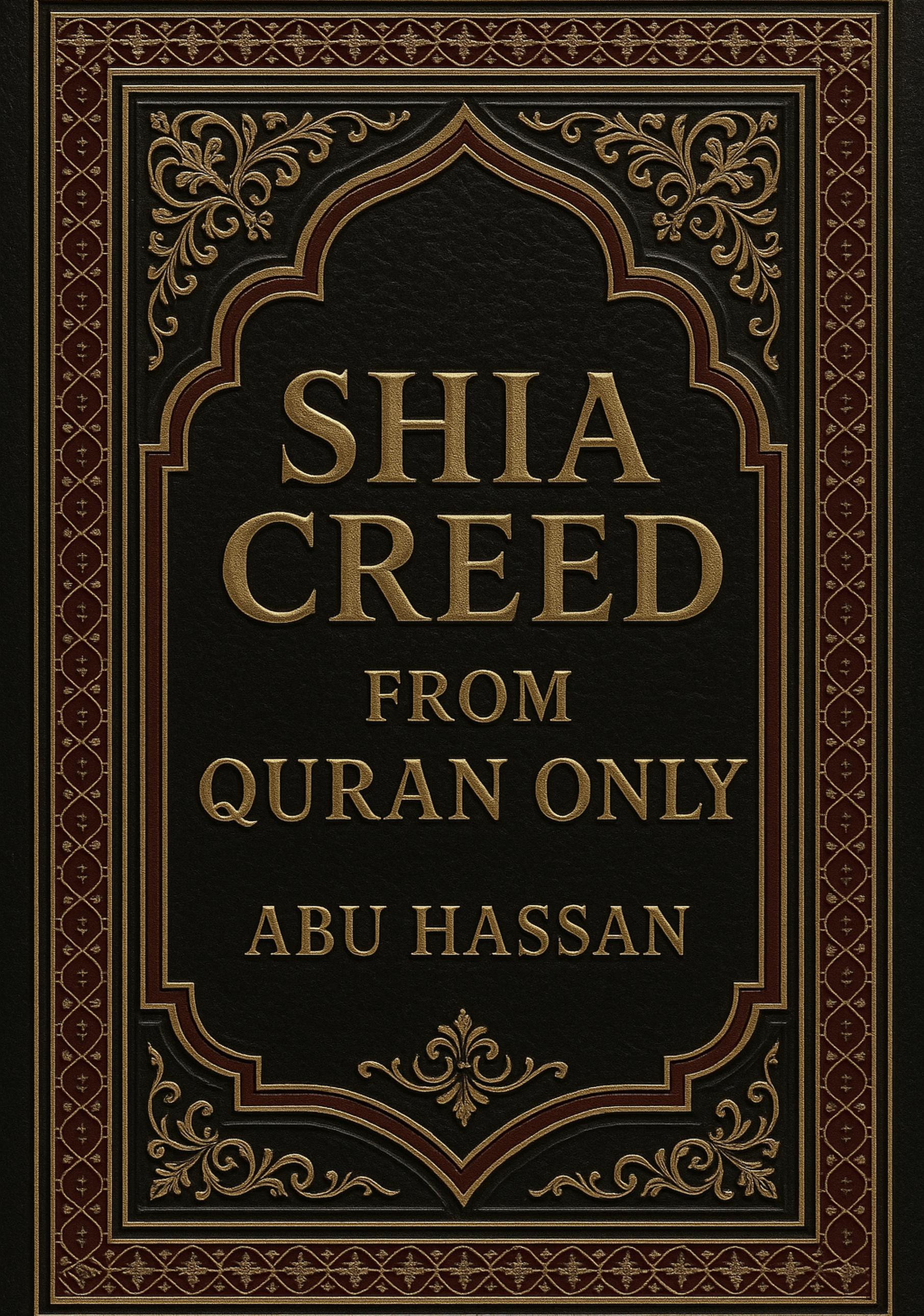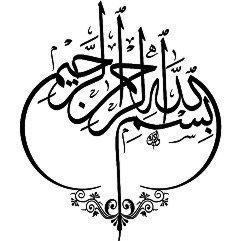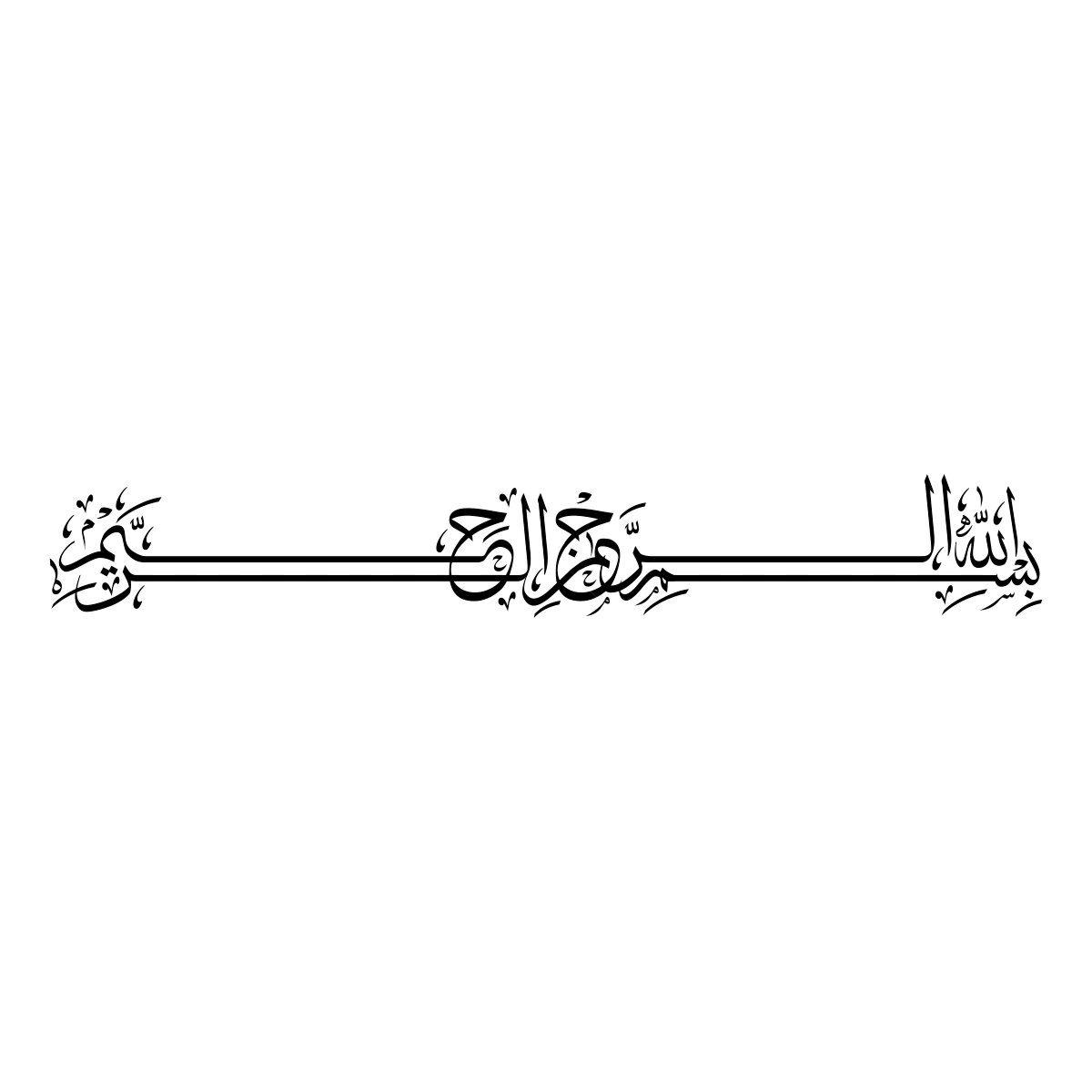







Writtenby: AbuHassan

"Andeasemytaskfor
me;
"Andmakeloose the knot(thedefect) from my tongue, (i.e. remove the incorrectness from my speech)
"That theyunderstand my speech"

©2025 AbuHassan
Publisher: BoD ∙ Books on Demand, Östermalmstorg 1, 114 42 Stockholm, bod@bod.se
Print: LibriPlureos GmbH, Friedensallee273, 22763 Hamburg, Tyskland
ISBN:978-91-8097-786-9


The Imamah in the Eschatological Context.............84
Conclusion: The Qur’an as the Primary Source of Imamah....................................................................85
Proof of Imamah –AVerse-by-Verse Qur’anic
The Qur’anic Proof of Imamah Through the Verse of Mubāhala....................................................................114
The Qur’anic Proof of Imamah Through the Verse of Tathir...........................................................................132 TheVerse and Its Linguistic
2. "Ahl al-Bayt" is aSpecific Group with Special Status.............................................134 3. Purity Implies Infallibility.....................
4. Political and Spiritual Leadership are Unified.......................................................136

Proof of Imamah from Surah al-Baqarah...............144 The Meaning of "Khalīfah"................................... 145 The Word "Inni Jāʿilun".........................................145
1. Divine Appointment: “Inni Jāʿil” as the Foundation of Divine Leadership....................146
2. Singular Usage: One Appointed Leader,Not a Collective System............................................146
3. The Angels’ Objection: ADemand for Infallibility.......................................................147
4. Adam as the First Khalīfah: Establishing the Model...............................................................147
5. Knowledge of the Names (ʿIlm al-Asmā’): Proof of Divine Knowledge in the Leader.......148
6. Spiritual Nature of the Khalīfah: Beyond Politics............................................................. 148
7. Iblīs’sRejection: ASymbol of Rebellion Against Divine Authority................................ 149
8. The Necessity of aContinuous Hujjah (Proof) on Earth............................................................149
9. Adam as the Origin of the Line of Divine Vicegerents...................................................... 150
10. The Inconsistency of the Sunni Model......150 Conclusion.......................................................151 Divine Appointment in the Qur'an –AnExegesis of Surah Al-Baqarah 2:247........................................... 153 Divine Authority Supersedes HumanJudgment....154

The Criteria for Divine Leadership........................155
Wealth and Social Status Are Irrelevant................156
Leadership Must Be Divine in Origin................... 157
Rebuttal of Ijmāʿ (Consensus)...............................158
The SpiritualNatureofDivine Leadership........... 159
Knowledge Is the Standard of Legitimacy............ 160 ARejection of Worldly Criteria.............................161 Divine Will Is Not to Be Overruled.......................162 Conclusion.............................................................162
Recognition of Imamah in Sunni Exegesis............164 The Eleventh Condition:..................................164
The Centrality of Knowledge (ʿIlm) in Divinely Sanctioned Leadership..............................................167
The Caseof Ṭālūt: Knowledge as aPrimary Criterion 167
The Case of Prophet Ādam: Knowledge as Proof of Divine Favor..........................................................169
Knowledge and the Prerequisite of Guidance....... 171
Theological Implications for the Doctrine of Imamah 172
The Qur’an’sRebuttal to Material or Tribal Criteria... 173
Conclusion: ʿIlm as the Unshakable Foundation of Divine Leadership..................................................174
Who possesses the divine knowledge necessary to guide the Ummah?.................................................175

Final Reflection: Sufficient Evidence for the Sincere
Qur’anic Evidences for Ghaybah (Occultation) and Imam al-Mahdi..........................................................
Allah’sIncomparability: “There is nothing like unto Him”......................................................................
Imam ʿAlī’s Sermon in Nahj al-Balāghah.............195

The Verse of Wuḍūʾ and the Evidence for Wiping the Feet..............................................................................200
Introduction............................................................200
TheVerseinQuestion............................................201
Grammatical Structure of the Verse.......................202
Why Wiping and Not Washing?............................203
Supporting Hadith from the Ahl al-Bayt...............204
Logical and Practical Wisdom...............................204
Responses to Common Objections........................205
Conclusion: The Qur’an Supports Wiping the Feet in Wuḍūʾ.................................................................... 206
The Qur’anic Basis for Performing Five Prayers in Three Intervals...........................................................208
Introduction............................................................208
The Qur’anic Verses Indicating Three Time Intervals 209
A. Surah al-Isrāʾ (17:78)............................209
B. Surah Hūd(11:114)...............................210
Prophetic Practice: Confirmation by the Sunnah...211
A. Ṣaḥīḥ Muslim, Book of Prayer..............211
Rationale Behind the ThreeIntervals....................212
Divine Wisdom and Mercy....................................213
Shia View: Five Obligatory Prayers, Three Intervals.. 213
Conclusion: AQur’an-BasedApproach to Prayer
Timing....................................................................214 9

The Obligation of Khums in the Qur’an.................216
Introduction............................................................216
The Central Verse: Surah al-Anfāl(8:41)..............217
The Arabic Word “Ghanimtum” and Its Scope.....217
The Structure of the Verse.....................................
A. Obligation:............................................219
B. Distribution:..........................................219
Khums vs. Zakāh: TwoDistinct Obligations.........220
Historical Practice During and After the Prophet’s Lifetime..................................................................221
Divine Wisdom and Societal Role.........................222
Misconceptions Addressed....................................223
1. “Khums is only for war booty”..............223
2. “Khums is not in the Qur’an”................223
Conclusion: AQur’anic Pillar of Financial Justice..... 223



Throughout Islamic history,the Shia community has nurtured beliefs and practices deeply rooted in the teachings of the Prophet Muhammad .This community treasures the legacy of the Ahl al-Bayt, the beloved family of the Prophet, as asource of spiritual guidance, moral clarity,and leadership.Yet,despite this rich spiritual heritage, Shia Muslims often face a common and painful accusation: that their faith lacks clear evidence from the Qur’an itself.


Many who raise this claim question whether the principles that distinguish Shia Islam, suchasthe concept of Imamate, the leadership and special status of the Prophet’sfamily,and certain theological understandings, have direct support in the divine scripture that all Muslims revere. To some, these beliefs appear to be based mostly on traditions, historical accounts, or scholarly interpretations rather than on the sacred text revealed by God.
This perception has caused misunderstanding and misrepresentation, both within Muslim communities and beyond. The accusation that Shia Islam is not firmly grounded in the Qur’an challenges the legitimacy of Shia

beliefs and sometimes leads to feelings of alienation among Shia Muslims themselves. It questions the authenticity of aspiritual path followed by millions for over fourteen centuries.

The Qur’an is the unaltered, divine revelation given to the Prophet Muhammad ,serving as the ultimate source of guidance for Muslims worldwide. For any Muslim, affirming that their beliefs align with the Qur’an is fundamental to their faith’sauthenticity.When accusations arise that certain doctrines lack Qur’anic basis, it shakes the very foundation of those beliefs.
For the Shia community,this is not merely an intellectual debate but amatter that touches hearts and souls. To be told that one's faith is not supported by the Qur’an is deeply painful, especially when that faith is built upon a lifelong devotion to the Prophet and his family.It raises questions that many Shia Muslims have wrestled with personally: Are we truly followingwhat the Qur’an teaches? Or are we mistaken in our understanding?

This doubt, often voiced by others, but sometimes internalized, has motivated me to embark on the journey of writing this book. Iwanted to answer these questions

not just for others, but for myself, seeking knowledge is part of faith. Seeking clarity,confidence and connection is ultimately done through the Qur’an itself.
To understand why such accusations persist, it is helpful to recognize the historical and theological context in which they arose.
From the earliest days after the Prophet’spassing, Muslims have differed in their understanding of who should leadthe community and how divine guidance should continue. The Shia position, emphasizing the spiritualand temporal leadership of the Prophet’s family,has at times been contested by other groups with differing views on succession and authority.

Over centuries, as sectarian identities formed, theological debates deepened. Some Sunni scholars and followers came to view Shia beliefs as deviations or innovations, often highlighting the reliance on traditions beyond the Qur’an, such as certain hadith collections or historical narratives, as away to challenge Shia legitimacy.
These debates were not always conducted in the spirit of mutual respect or understanding. At times, polemics and

misunderstandings hardened divisions, making it harder for sincere seekers to explore the truth openly.For me, hearing theseaccusations was more than an academic challenge, it was adeeply personal experience.

Growing up in aShia household, Iwas taught to love and revere the Prophet’sfamily and to see them as the rightful guides appointed by God. Yet, as Iengaged with broader Islamic discussions, Iencountered repeated claims that our beliefs had no firm Qur’anic foundation. Sometimes, these claims came from respected scholars, other times from friends or acquaintances curious or confused about Shia doctrine.
At first, thesedoubts felt overwhelming. How could so many devoted Muslims be wrong about such central truths? WasImisled by tradition? Did Itruly understand the Qur’an correctly?
Rather than retreat into defensiveness or silence, Ifelt compelledtoseek answers. Iturned to the Qur’an itself, reading and reflecting deeply on its verses. Iconsulted scholarly works from diverse perspectives. Iprayed for guidance.

Over time, aprofound realization emerged: the Shia creed is not only compatible with the Qur’an but is, in fact, beautifully and deeply woven into its very fabric.
The Qur’an speaks clearly about the importance of the Prophet’sfamily,divine guidance, and the qualities of true leadership. These teachings are present for anyone willing to look with an open heart and mind.
This book is my humble effort to share what Ihave learned and to respond to the doubts and accusations that surround Shia Islam. It is written with respect and love for all Muslims, whether Sunni or Shia, and with the hope that it can serve as abridge of understanding.
My goal is not to engage in polemics or to dismiss others’ beliefs but to present the Shiacreed directly from the Qur’an. Iwant to show that our beliefs are not inventions or later additions but are grounded in the sacred text that unites all Muslims.
Ialso wish to provide reassurance for Shia Muslims who may struggle with their faith when confronted with criticism. Knowing that the Qur’an itself supports and affirms the Shia worldview can strengthen confidence anddeepen spiritual conviction.

